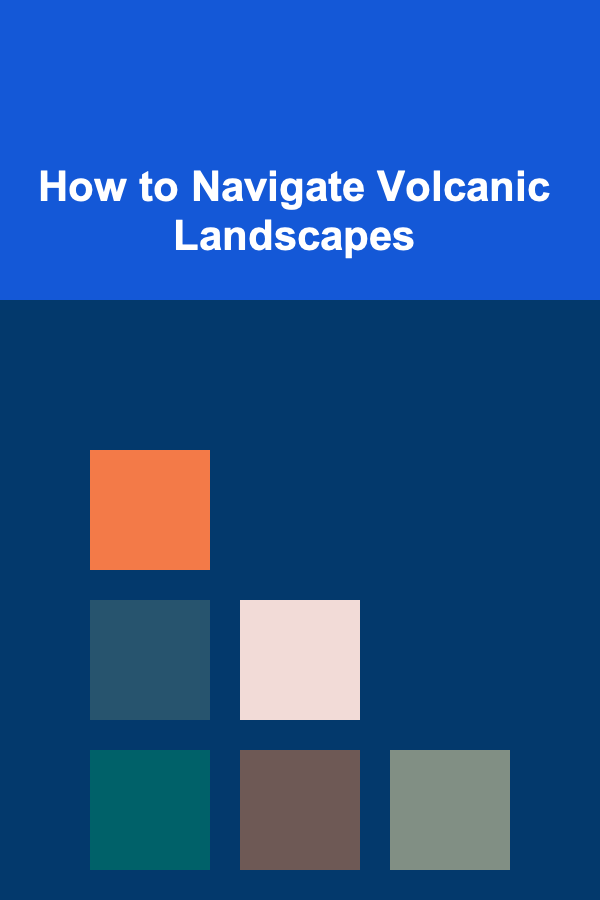
How to Navigate Volcanic Landscapes
ebook include PDF & Audio bundle (Micro Guide)
$12.99$10.99
Limited Time Offer! Order within the next:

Volcanic landscapes, with their dramatic and dynamic terrain, offer both breathtaking beauty and daunting challenges for those who venture into them. From the rugged lava flows to the craters of active volcanoes, these environments present unique opportunities for exploration, scientific study, and adventure. However, they also come with inherent risks and require specific knowledge and preparation to navigate safely.
This article will delve into the various aspects of volcanic landscapes, exploring their formation, the hazards associated with them, and the essential guidelines for safely navigating these awe-inspiring yet hazardous terrains. Whether you are a seasoned adventurer or a curious traveler, understanding the nuances of volcanic landscapes will enrich your experience and help you appreciate the power of our planet's geological forces.
The Formation of Volcanic Landscapes
To understand how to navigate volcanic landscapes, it is first essential to understand how they are formed. Volcanic landscapes are the result of geological processes that occur when magma from the Earth's mantle reaches the surface, erupting as lava and ash. These eruptions can create a variety of landforms, ranging from towering volcanic cones to expansive lava plateaus.
Types of Volcanic Landforms
-
Shield Volcanoes
Shield volcanoes are large, broad, and gently sloping landforms that form from the eruption of low-viscosity lava, which can flow over great distances. These volcanoes are typically found in areas with frequent but non-explosive eruptions, such as the Hawaiian Islands. The lava from shield volcanoes creates expansive, relatively flat terrains.
-
Stratovolcanoes (Composite Volcanoes)
Stratovolcanoes are steep-sided, cone-shaped mountains formed by a combination of explosive eruptions and lava flows. These volcanoes tend to erupt more violently than shield volcanoes, producing pyroclastic flows and significant ash clouds. The famous Mount St. Helens and Mount Fuji are examples of stratovolcanoes.
-
Calderas
A caldera is a large volcanic depression formed when a volcano erupts so violently that its magma chamber empties, causing the ground above to collapse. These formations can be vast and contain lakes or geothermal features. The Yellowstone Caldera in the United States is one of the largest and most well-known examples.
-
Lava Plateaus
Lava plateaus form when large volumes of basaltic lava erupt and spread across vast areas, often forming extensive flatlands. These landscapes can be found in places like the Deccan Plateau in India and the Columbia River Plateau in the United States.
-
Volcanic Islands
Volcanic islands are formed when volcanic eruptions beneath the ocean surface result in the accumulation of lava that eventually breaks the ocean's surface, creating islands. The Galápagos Islands and Iceland are examples of volcanic islands that have rich ecosystems and diverse geological features.
Volcanic Eruptions and Their Impact
Volcanic eruptions, which drive the formation of volcanic landscapes, vary in intensity. Some eruptions are relatively gentle, producing flowing lava, while others can be catastrophic, generating pyroclastic flows, ash clouds, and even tsunamis. The severity of an eruption depends on factors like the magma's composition, the pressure in the volcano's chamber, and the type of eruption.
- Effusive Eruptions: These eruptions occur when magma is relatively low in viscosity, allowing it to flow easily. Lava flows from the volcano in streams or sheets, sometimes traveling great distances. Effusive eruptions are typically less dangerous to human life, though they can cause significant destruction to property.
- Explosive Eruptions: These eruptions happen when magma is highly viscous, trapping gas and building up pressure until it is released explosively. This type of eruption can produce pyroclastic flows (fast-moving hot gases and debris), ashfall, and even volcanic bombs. These eruptions are far more dangerous to nearby populations and can alter local climates.
- Phreatomagmatic Eruptions: These occur when water comes into contact with hot magma, resulting in explosive interactions that produce ash, steam, and pyroclastic debris. These eruptions are typically violent and dangerous due to the unpredictable nature of the interaction between magma and water.
Hazards of Volcanic Landscapes
Volcanic landscapes are both captivating and hazardous, with numerous dangers that require careful consideration when exploring. While volcanic areas can be a haven for geologists, hikers, and adventure seekers, it is crucial to be aware of the risks and how to mitigate them. Here are some of the primary hazards associated with volcanic landscapes.
1. Lava Flows
Lava flows are one of the most well-known hazards of volcanic landscapes. The lava can flow for miles, destroying everything in its path. While the speed of lava flows varies depending on the viscosity of the magma, they generally move slowly enough that people can avoid them if they are alert. However, the heat emitted by the lava can be intense, and getting too close to an active flow can result in burns or worse.
2. Pyroclastic Flows
Pyroclastic flows are fast-moving currents of hot gas, ash, and volcanic rocks that descend from a volcano during an explosive eruption. They are extremely dangerous due to their speed (often traveling up to 100 km/h or 60 mph), high temperatures, and the sheer volume of material they carry. Pyroclastic flows can obliterate anything in their path, and they are responsible for many fatalities in volcanic eruptions.
3. Volcanic Ash
Volcanic ash consists of fine particles of pulverized rock and mineral fragments ejected from a volcano during an eruption. Ash can travel vast distances, affecting air quality, human health, and infrastructure. Inhaling volcanic ash can cause respiratory problems, and it can also damage crops, buildings, and machinery. The weight of accumulated ash on structures can lead to collapse, especially in areas with heavy ashfall.
4. Gas Emissions
Volcanic gases, such as sulfur dioxide (SO2), carbon dioxide (CO2), and hydrogen sulfide (H2S), are often emitted during volcanic activity. High concentrations of these gases can be toxic, and their release can lead to acid rain, which can damage ecosystems and human health. Areas near active volcanoes should be monitored for changes in gas emissions to predict potential hazards.
5. Landslides and Lahars
Landslides and lahars (volcanic mudflows) can be triggered by volcanic eruptions or heavy rainfall, particularly on the slopes of a volcano. Lahars can travel quickly down river valleys, carrying mud, debris, and volcanic ash. These mudflows can destroy communities and infrastructure in their path, making them one of the deadliest volcanic hazards.
6. Earthquakes
Volcanic activity is often associated with seismic activity, as magma moves beneath the surface. Earthquakes can be a sign of impending volcanic eruptions, but they can also be an independent hazard, causing damage to structures and triggering landslides in volcanic regions.
7. Tsunamis
When an underwater volcano erupts or a large portion of a volcano collapses into the ocean, it can trigger a tsunami. These waves can travel great distances and cause destruction along coastlines. Tsunamis triggered by volcanic eruptions are less common but are still a significant hazard for people living near volcanic islands or coastal regions.
Preparing for and Navigating Volcanic Landscapes
Navigating volcanic landscapes requires preparation, knowledge of the terrain, and a deep understanding of the specific risks posed by the region you are exploring. Here are key considerations and strategies for safely navigating these dynamic environments.
1. Research the Area
Before embarking on a journey to a volcanic region, thorough research is essential. You should gather information on:
- The current activity level of the volcano (active, dormant, or extinct)
- Recent eruptions or seismic activity
- Available infrastructure (e.g., roads, trails, shelters)
- Accessibility and potential evacuation routes
Consulting local authorities, geological surveys, and official volcano monitoring agencies will provide you with the most up-to-date and reliable information.
2. Understand Local Warning Systems
Many volcanic regions have established warning systems to alert residents and visitors to imminent dangers. These can include:
- Volcanic ash warnings via local meteorological agencies
- Earthquake alerts that signal volcanic activity
- Evacuation plans in case of an eruption or lahar
Familiarizing yourself with these systems is critical for making quick decisions in the event of an emergency.
3. Appropriate Gear
The right gear is essential for safely navigating volcanic landscapes. This includes:
- Sturdy, heat-resistant boots for walking on rough or hot surfaces
- Protective clothing (e.g., long sleeves and pants) to guard against falling ash, rocks, and lava splatter
- Gas masks or respirators for protection from inhaling volcanic ash
- Helmets and gloves for protection in active or unstable areas
- Maps and GPS devices for navigation in remote areas
- First aid kits with emergency supplies for burns, cuts, and respiratory issues
4. Navigating Lava Flows and Craters
When navigating lava fields, it's important to stay on marked paths or trails that avoid active flows. Lava can be unpredictable, so maintaining a safe distance is essential. If you plan to approach a volcanic crater, make sure you are aware of the dangers, such as sudden gas emissions or unstable ground.
5. Avoid Risky Areas During Eruptions
If an eruption is imminent or underway, the safest course of action is to stay far away from the volcano. Evacuate the area if advised by local authorities, and avoid areas downwind of the volcano where ash and gases may be concentrated. Always heed local warnings and evacuation orders.
6. Take Part in Guided Tours
For those who are new to volcanic landscapes or exploring a particularly dangerous area, guided tours with experienced guides are a wise choice. Local experts are familiar with the terrain, the specific risks, and the safest routes to take. They can also provide valuable insights into the geological features of the landscape.
7. Monitor Weather and Conditions
Weather conditions in volcanic regions can change rapidly, with ash clouds reducing visibility and sudden rain triggering lahars. Always be prepared for shifts in weather and volcanic activity by monitoring forecasts and staying aware of any sudden changes.
Conclusion
Navigating volcanic landscapes is an adventure that requires a deep respect for nature's power and the knowledge to stay safe amidst its awe-inspiring beauty. By understanding the geological forces at play, recognizing the hazards involved, and preparing thoroughly, explorers can make the most of their experience while minimizing risks. Volcanic terrains, though dangerous, offer some of the most unique and rewarding landscapes on Earth, and with the right precautions, they can be navigated safely and successfully.

How to Remove Stubborn Stains from Carpets and Upholstery
Read More
Tips for Remote Job Seekers with No Experience: An Actionable Guide
Read More
Understanding Reincarnation in Mythology: A Deep Dive
Read More
Designing Custom Tool Organizers for 3D Printing: A Comprehensive Guide
Read More
How to Use a Personal Loan for Home Improvement Projects
Read More10 Mistakes to Avoid When Tracking HELOC Expenses
Read MoreOther Products

How to Remove Stubborn Stains from Carpets and Upholstery
Read More
Tips for Remote Job Seekers with No Experience: An Actionable Guide
Read More
Understanding Reincarnation in Mythology: A Deep Dive
Read More
Designing Custom Tool Organizers for 3D Printing: A Comprehensive Guide
Read More